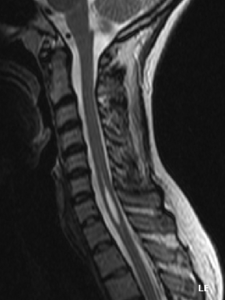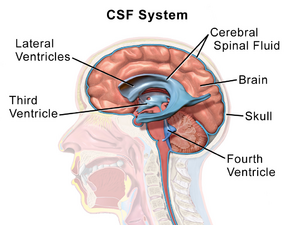Syringomyelia
Original Editor - Nick Libotton
Top Contributors - Nick Libotton, Wendy Walker, Nikhil Benhur Abburi, Kim Jackson, Lucinda hampton, Naomi O'Reilly, WikiSysop, 127.0.0.1, Admin, Rachael Lowe, Evan Thomas, Vidya Acharya and Aminat Abolade
Introduction[edit | edit source]
Syringomyelia refers to a cystic collection, or syrinx, that occurs within the spinal cord around the central canal. It is a rare neurogenic disease. As the cyst gets larger, it presses on the spinal cord and interferes with the transmission of nerve impulses. Syringomyelia predominantly presents with sensory symptoms such as pain and temperature insensitivity.
- Causes include congenital brain defects, spinal cord trauma and infection.
- Without treatment, syringomyelia may result in paraplegia or quadriplegia. Treatment options include surgery.[1]
- Syringomyelia accounts for up to 5% of paraplegia. The quality of life in syringomyelia patients is comparable with that of patients with heart failure or malignant neoplasms.[2]
Types[edit | edit source]
Types include:
- Syringomyelia due to blockage of CSF circulation (without fourth ventricular communication): Representing at least 50% of all cases, this is the most common type of syringomyelia.
- Syringomyelia with fourth ventricle communication: Approximately 10% of syringomyelia cases are of this type.
- Syringomyelia due to spinal cord injury: Fewer than 10% of syringomyelia cases are of this type.
- Idiopathic Syringomyelia has an unknown cause and cannot be classified under any of the previous categories[3]
Epidemiology[edit | edit source]
Epidemiological data on syringomyelia is limited. Some studies have found the prevalence of syringomyelia to be from 8.4/100,000 to 0.9/10,000 with ethnic and geographic variation. The majority of the patients present between the ages of 20 to 50.[2]
Characteristics/Clinical Presentation[edit | edit source]
Patients with this condition demonstrate a wide variety of neurological symptoms depending on where exactly the syrinx is located, but classically patients present with:
- Cape-like loss of pain and temperature sensation along the back and arms, known as a ‘suspended sensory level’
- Disproportionately greater bilateral motor impairment in upper compared to lower extremities
This motor and sensory impairment can eventually cause atrophy, which begins in the hands and progresses proximally, resulting in deformities such as 'claw hands' and Charcot’s arthropathy[4]
Watch this informative 5 minute video.
Diagnostic Procedures[edit | edit source]
The procedure for identifying Syringomyelia varies depending on the patients’ complaints. A neurological exam should rule out most of the symptoms we find in Syringomyelia[6] Also, a well-executed anamnesis is one of the main diagnostic procedures in identifying this disease. Furthermore, we look for symptoms as we have seen in the ‘differential diagnosis’ topic.
Treatment[edit | edit source]
The goal of treatment is to correct the underlying causative pathophysiology. All current treatment strategies are directed toward improving CSF flow dynamics.[2]
Physical Therapy Management [edit | edit source]
The physical therapy for patients suffering from Syringomyelia differs depending on the location and impact of the disease unless presented with an MRI, a neurological examination should clear out at which level the syrinx occurs. The goals of the treatment are to stop the spinal cord damage from getting worse using the techniques explained in the following paragraph and to maximize functioning. They may require active physical therapy, passive mobilizations, occupational therapy or even speech therapy.
We try to focus the therapy on the following subjects:
- Increasing their muscle strength (Usually upper extremity and paravertebral muscles, using training schemes individualized to the patients’ tolerance)
- Maintaining range of motion using stretching and mobilizations of the neck and upper limb.
- Training neck stability (best guided by physiotherapist at first)
- Sitting and standing balance can be physical and occupational therapy (referring to daily activities as in getting dressed and grooming)
- Educating the patients about their disease and it’s process over time. It is important to maintain an active lifestyle but there are several risks in high impact activities which should not be overlooked. (See topic “patient advice during follow up after surgery) They should also learn about adequate pain management and coping techniques
- Improving and/or maintaining communication using speech therapy (when the syrinx is present in the lower brain stem, although that should be referred to as ‘syringobulbia’)
- Maximizing functional capabilities by testing and asking the patient about daily activities and then acting upon the answers. This includes activities such as getting in and out of bed, walking, using a cane or crutches and such. Physical therapists may also refer a patient to the use of leg braces if they are deemed appropriate.
Patient advice during follow up after surgery:
Hospital Course: pain relief will be the most significant factor. Therefore it is important the patient receives a lot of bed rest and moves carefully.[7]
- During the first month after surgery: when the operation is successful, the pain and neurological symptoms should improve rapidly. The patient should try to maintain a modestly active lifestyle. It is important that these patients try to avoid tasks involving heavy lifting! Walking and performing daily activities at ease is highly recommended.
- On the long term: an adequate follow-up is very important for these patients. If they do not deteriorate, they should try to maintain a relatively active lifestyle.
- Avoid:
- Activities that cause excessive strain on the nervous system and spinal cord.
- Any activity in which high impact can be expected (e.g. football, rugby…)
- Avoid straining due to heavy bowel movement
- Avoid extensive coughing
- Most important: Avoid heavy lifting and straining
References[edit | edit source]
- ↑ Better Health Channel Syringomyelia Available: https://www.betterhealth.vic.gov.au/health/conditionsandtreatments/syringomyelia(accessed 8.5.2022)
- ↑ 2.0 2.1 2.2 Shenoy VS, Sampath R. Syringomyelia. 2022 Available: https://www.ncbi.nlm.nih.gov/books/NBK537110/(accessed 8.5.2022)
- ↑ Kim J, Kim CH, Jahng TA, Chung CK. Clinical course of incidental syringomyelia without predisposing pathologies. Journal of Clinical Neuroscience. 2012 May 1;19(5):665-8.
- ↑ Radiopedia Syringomyelia Available: https://radiopaedia.org/articles/syringomyelia(accessed 8.5.2022)
- ↑ Soton brain hub Syringomyelia rapid review Available from: https://www.youtube.com/watch?v=KLH-3SzsPYM [last accessed 30/9/2020]
- ↑ Heiss JD, Patronas N, DeVroom HL, Shawker T, Ennis R, Kammerer W, Eidsath A, Talbot T, Morris J, Eskioglu E, Oldfield EH. Elucidating the pathophysiology of syringomyelia. Journal of neurosurgery. 1999 Oct 1;91(4):553-62.
- ↑ Benzel EC, Sridharan S, Krishnaney AA, Henwood A, Wilke WS: The ChiarifckLRMalformation and Fibromyalgia, Part II: Management. ASAP Connections.fckLRMay/June 2002








